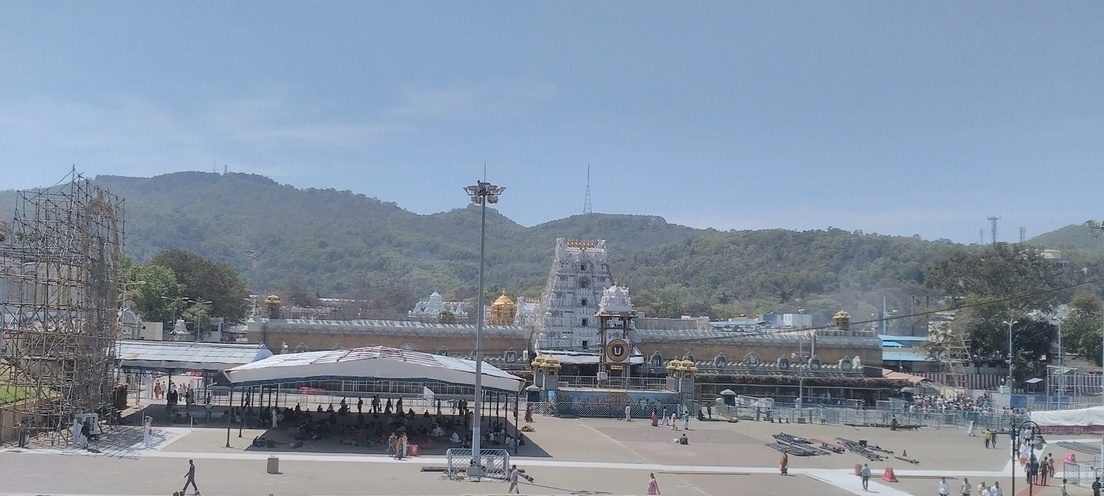
The call of “Govinda Govinda” fills the air, the name of god rising above the clatter of the crowds. In between breaths, from somewhere amongst the crowd, a child’s sweet voice rises up and fills the spaces with the same chant. The zest that the devotees have to see their god is palpable enough to reinvigorate the spirits of everyone around them who have been standing in the queue for a couple of hours now. The heavy rush, non-stop chanting, high security, heavily adorned idol and the compelling aura around the deity – everything about Tirupati is simply alluring.
The Tirupati Balaji or Shree Venkateshwara Swami temple is one of the most pivotal landmarks of the Hindu mythology, holding a magnificent position in the Chittoor district of Andhra Pradesh. Tirupati Balaji temple is located in Tirumala hills, 18 Kms from Tirupati town. Tirumala hills when viewed from the air appear to be coiled like a serpent with seven prominent peaks making it one of the best tourist places in Tirupati. This is what has probably led to the name― Seshachala―the mountain of Sesha―the divine serpent with seven hoods, also called Adisesha, on whom Lord Vishnu reclines. The seven peaks are named Seshadri, Vedadri, Garudadri, Anjanadri, Vrishabadri, Narayanadri and Venkatadri.
LEGEND
According to the Hindu calendar, time is split in four cons (yugas), that succeed each other in a cyclical manner. Sar Yuga, Treta Yuga, Dwapara Yuga and Kali Yuga. The Yugas are of several billions of years and that vary in the goodness, evilness and godliness of their inhabitants. We are presently in the Kali Yuga, the worst of the lot when evil dominates the universe and which ends in apocalypse.
As per the legend Goddess Lakshmi after having an argument with her beloved, Lord Vishnu, left Vaikuntha (abode of Gods) and descended on Earth. Seeking to make up with her, Lord Vishnu too came down and started searching for his consort. He roamed the entire planet, devoid of food and shelter and spent all his energy in the search. After many futile attempts he decided to rest for a while and found shelter on a hilltop in the Seshachalam. During His time on the hill, Vishnu adopted a very humble way of life. While on a walk in a nearby forest one day, He met Padmavathi, princess of the Chandra dynasty. Both of them developed an instant liking for each other, as was destined. Padmavathi had taken a rebirth as a princess and was meant to meet and eventually marry God Vishnu, and so they did. Since the princess was rich, for the wedding, Vishnu took a loan from Kuber. the richest of Gods. He promised to repay the loan to Kuber as well as the interest. It is said that the Lord is still paying back the interest on the loan, and devotees throng the temple to help the Lord with their small contribution to his cause. When Goddess Lakshmi heard of the marriage, she confronted Vishnu and only calmed down when he explained how all of this was destined. By this time, the Kal Yuga was nearing and the god was able to see all the evil coming on the face of this planet and so he decided to stay here till the end of this yuga and help all his devotees. He manifested himself into an idol of stone and rested on top of the Sheshachalam hill range, where the Tirumala temple is.

The journey starts from Tirupati, a city at the foot of the Sheshachalam hill range. Whether coincidently or as a corroboration to the God’s presence at the top of the range the hill are seven in number and for the believers symbolise the seven heads of Adishesha, the king of serpents, on which Lord Vishnu can be seen resting in most of his perceived images. These hills that measure 8,000 square km are said to be more than 500 million years old, with the temple at the top, being 2,500 feet above sea level. Natural Arch in the Tirumala Hills is a distinctive geological wonder located 1 km (0.6 mi) North of the temple, near the Chakra Teertham. The Arch is also called Silathoranam in Telugu (“Sila” means ‘rock’ and “thoranam” means a garland strung over a threshold, connecting two vertical columns or an ‘arch’ as in this case). The arch measures 8 m (26.2 ft) in width and 3 m (9.8 ft) in height, and is naturally formed in the quartzites of Cudappah due to natural erosive forces. This is the only place wherein such stones are seen in this world. The age of these stones is reckoned about 2500 million years.
Tirupati Balaji Temple holds a special significance amongst Hindus. According to the religion, Hinduism says that there are a total of 8 Vishnu Swayambhu Kshetras and Tirupati is one of them. Also, this temple is mentioned by the Tamil Azhwar saints to be one amongst 108 Vishnu temples, to be present in the earthly realms.

Only government APTDC buses and private cars/vans are allowed to go uphill. When at the foot of the hill, a thorough security check is conducted for all the visitors and only after a clearance are they allowed to travel up the hill. Devotees can choose how they would reach the uphill from the below three ways.
1.Trek through the Srivari Mettu route, which is the shortest one.
2. Trek through the Alipiri Mettu route that is nine km in length , the most preferred route by devotees who choose to reach the temple on foot.
3.The third route is from where devotees can drive up the seven hills.
The temple is a fine example of seventh century Dravidian architecture. These temples are distinct in style and are found only in southern India. They are known for their four gopurams (entrances) and mandapams (pillared halls), which not just make for their unique architecture but also follow a particular design. The Sculptures on the walls of the temple tell the stories of different dynasties that built the temple. The first time a temple structure was build around the idol was in 19th century during the Pallava dynasty which was followed by modifications made by the ruler of the Chola dynasty in the 11th century. In the 14th and 15th century the Vijayanagara dynasty constructed several other monuments in Southern India lent its own style to this temple complex also, which can be easily observed and compared to other temples built by the dynasty in the same period.
The temple has various stone engravings from different ruling administrations of history. The Dravidian Style construction included the use of sandstones, granites and soapstones. There are about 1180 engravings out of which 139 belong to the ruling period of Kondoi Veedu, 229 belong to King Krishna Deva Rayar, 147 belong to Sadasiva Rayar, 251 belong to Achchuthan Rayar period, 169 belong to Chalukya Kings ruling period and 236 belong to the Chola period.
As per the Vaikhanasa traditions, the deity is worshipped six times a day. Ushakala, Prathakala, Madhyanika, Aparahaa, Sandhyakala and Ardharatri Aradhana are the six aradhanas done for the deity.
BALAJI DARSHAN / SHEEGRA DARSHAN

Tirumala is the most popular temple on the earth today inviting the maximum number of devotes on any given day and attracting the largest amount of donations also on a daily basis. Devotees pray the Lord to fulfill their wishes and upon their wishes getting fulfilled, it is a customary practice to offer their donations at the temple Hundi.
Once at the top, the devotees can choose to stand in the long queue, that can run upto ten hours, or opt for a sheegra darshan by paying a nominal fee of INR 300 per head.. To ease the wait for 15 hours, the temple administration has organised facilities like resting galleries, sale of hot beverages as well as food, and even medical facilities just adjacent to where the queues run. eventually they come to the main sanctum, one of the four entrance to the main temple from where all entries and exits are made. Senior citizens and differently abled persons have separate queue for darshan by producing their ID card and medical certificates. For them normally entry is through Dakshina nada gate (Timing 10 AM & 3 PM)
On daily basis the temple attracts nearly 60,000 devotees, from all over India and other parts of the world. So, it’s about the god’s calling, as many believe, without which no one can see him. As every devotee brings offerings as per their capacity, the Tirumala temple has, over the decades, become the richest in the country. Devotees bring cash, gold, precious stones, jewellery, expensive metals, stones, flowers and herbs as offerings for the Lord. Often, the temple receives several kilos of gold ornaments a day. There is a legend around Lord Vishnu that makes devotees stretch their budgets for making an offering at this temple, Legend has it that Lord Vishnu, who had taken a loan from Kuber the Lord of Wealth, has to repay his loan entirely soon and hence the devotees contribute their mite to the Lord’s efforts.
The cloth that is used to wrap around Venkateshwara is 23 yards and weighs 6 kg.Its made up of special type of silk called Pitambaram. You can’t buy it in shops but if you want to offer it to God ,you can order your colour and type of cloth in the Temple office by giving a certain amount of money and you should wait for 3 years to see your cloth to be offered and wraped around the vigraham.
Lord Balaji’s idol has a specific temperature always maintaining 110 degrees Fahrenheit. But the temple is situated at a height of about 3000 feet which means the climate is normally cold up there and every morning at 4:30 am after the Abhishekam Lord Venkateswara Swamy is done with water, milk as well as other holy and divine dravayam, sweat appears in the form of fine water drops and particles on the idol or Lord Balaji’s body which is also wiped off with a silk fabric cloth. Even on every Thursday when ornaments are removed from the idol before the sacred bath it is always noticed that they remain warm.
As against the Vishnu Sahasra namam chanted at archana in other Vishnu temples, only the Venkatesha Sahasra namam is chanted here. Also the Suprabhataham, the chanting to wake up the Lord is not played in the temple during the month of Margazhi ( Dec-January) as he never sleeps.
HAIR TONSURE AT TIRUMALA

Kalyanakatta where your hair can be offered. Most devotees coming to the temple also shave off their hair as a sign of letting go of their egos and pride and surrender to the Almighty. According to the Hindu Triumvirate, Brahma is the Creator, Vishnu the Organiser and Shiva the Destroyer. It is estimated that more than a crore people tonsure their heads annually at the hill shrine. In peak season, 45,000-50,000 people get their heads tonsured daily at the TTD’s 16 tonsuring halls, two of which stay open round the clock. Now-a-days e-auctioning is taking place and it attracts traders across the world. The temple authorities auction 6 categories of hair depending on length and texture. First category of hair (31” and above) will fetch more than Rs 27,563 per kg.
PRASADAM – TIRUPATI LADDU

Tirupathi laddu has a GI (Geographical Identification) Patent making it arguably the first offering at a place of worship anywhere in the world to be recognized as an intellectual property (IP)—in this case, of the Tirumala Tirupati Devasthanams (TTD), a trust that manages the temple at Tirupati. The GI status is granted to identify a product as having a specific provenance, and with a certain quality or reputation associated with that origin. Kashmir pashmina, Darjeeling tea and Kancheepuram silk have all been granted GIs.
5 MAJOR THINGS TO DO AT TIRUPATI

1. Puskarini Tank, a water tank close to the main temple is a sacred place to visit. It is believed that Lord Venkateshwara took bath in this Pushkarani and a dip in it is considered as most auspicious one. . The water from here is used for temple cleaning purposes. All devotees are required to purify themselves here.

2. TTD runs free buses both at Tirupati and Tirumala. The name of the bus is “Dharmaradham”, an orange color bus. These buses run like hop-on – hop off kind free services. Catching thisbus is the best option for roaming inside Tirumala area. The bus covers the below mentioned stops
1. GNC 2. HVC 3. Annamaiah Bhavan 4. Padmavathi Enquiry Office 5. Ashwini Hospital 6. RTC Bus Stand. 7. CRO Office 8. Saptagiri circle 9. SMC 10. Vaikuntam-1 11 MBC 12. JEO Camp Office 13. S.V Canteen 14. Narayanagiri Cottages 15. Museum 16. Vaikuntam:2 for Sarva Darshan 17. Karnataka Bhavan 18. Varahaswamy Guest house 19. Rambageecha Guesthouse 20. S.V Shopping Complexes 21. Main Annadana Satram 22. Main Kalyanakatta
3.Just one kilometre towards the North of the temple is Shila Thoranam, or the great Geological Arch. A rare archaeological wonder, visit and listen to stories about various mythological folklore around it.
4. Three kilometres from the temple is the Akashganga Waterfall, a supposedly divine waterfall as it is located in the hills.
5. The Papa Vinashanam Reservoir is another water body where one can bathe to cleanse all sins. This is at a picturesque location about 5 kilometres from the temple.
TRAVEL TIPS: THINGS TO TAKE CARE BEFORE GOING FOR TIRUPATI DARSHAN

1. Wear appropriate clothings – Tirupati is a town for devout pilgrims and it is best for women to be dressed in Indian traditional dresses like a saree or a suit with dupatta. Wearing of sleeveless, shorts and jeans are not aloowed inside temple. AND mens to wear dhotis.
2. Not Consume alcohol and non-vegetarian food – After consuming alcohol and non vegetarian food, don’t go for darshan. Tobacco items are also banned in the hills.
3. Carry phones/cameras/video cameras inside the temple – It is forbidden to carry any recording device inside the temple during darshan. Lockers are provided to stow such gadgets.
IMPORTANT FESTIVAL DATES AT TIRUPATI TEMPLE
| DATE | WEED DAY | OCCASION |
| 01-01-2021 | FRIDAY | NEW YEAR |
| 02-01-2021 | SATURDAY | NEW YEAR |
| 13-01-2021 | WEDNESDAY | BHOGI |
| 14-01-2021 | FRIDAY | MAKARA SANKRANTHI |
| 15-01-2021 | TUESDAY | GODA PARINAYAYOTSAVAM |
| 19-02-2021 | FRIDAY | RATHASAPTHAMI |
| 06-04-2021 | TUESDAY | KOIL ALWAR THIRUMANJANAM |
| 13-04-2021 | TUESDAY | UGADI |
| 13-07-2021 | TUESDAY | ANIVARAASTHANAM |
| 16-07-2021 | SATURDAY | ANIVARAASTHANAM |
| 05-10-2021 | TUESDAY | KOIL ALWAR THIRUMANJANAM (ANNUAL BRAHMOTSAVAM) |
| 06-10-2021 | WEDNESDAY | ANNUAL BRAHMOTSAVAM -ANKURARPANAM |
| 07-10-2021 | THURSDAY | ANNUAL BRAHMOTSAVAM- DAY1 |
| 08-10-2021 | FRIDAY | ANNUAL BRAHMOTSAVAM – DAY2 |
| 09-10-2021 | SATURDAY | ANNUAL BRAHMOTSAVAM – DAY3 |
| 10-10-2021 | SUNDAY | ANNUAL BRAHMOTSAVAM- DAY4 |
| 11-10-2021 | MONDAY | ANNUAL BRAHMOTSAVAM – DAY5 GARUDA SEVA |
| 12-10-2021 | TUESDAY | ANNUAL BRAHMOTSAVAM – DAY6 |
| 13-10-2021 | WEDNESDAY | ANNUAL BRAHMOTSAVAM – DAY 7 |
| 14-10-2021 | THURSDAY | ANNUAL BRAHMOTSAVAM – DAY8 |
| 15-10-2021 | FRIDAY | ANNUAL BRAHMOTSAVAM – DAY 9 |
| 16-10-2021 | SATURDAY | BHAGSAVAI UTSAVAM |
| 04-11-2021 | THURSDAY | DEEPAVALI ASTHANAM |
| 16-11-2021 | TUESDAY | KAISIKA DWADASI |
| 08-12-2021 | THURSDAY | PAT PANCHAMI THEERTHAM |
| 31-12-2021 | FRIDAY | NEWYEAR EVE |

Hope the above information helps you for your Balaji darshan.
“..Sri Venkatesah Sreenivaaso Lakshmeepathi Ranaamayaha..Amritamsuh Jagadhvandhyo Govinda Saaswatha Prabhuhu..”









